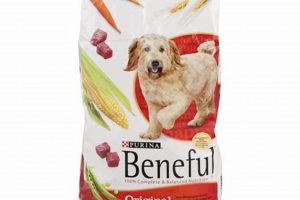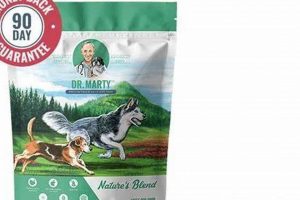The presence of insect reproductive material on canine sustenance indicates potential contamination. This can occur when suitable conditions allow certain flying insects to deposit their eggs on exposed pet food. For instance, open bags of kibble left in warm environments are susceptible to this type of infestation.
The significance of this issue lies in the potential health risks to the animal consuming the compromised food. Ingesting contaminated material can lead to gastrointestinal upset, allergic reactions, or even the transmission of certain pathogens carried by the insects. Historically, proper food storage and hygiene practices have been recognized as effective preventative measures.
The following sections will detail the types of insects commonly involved, the potential health implications for dogs, preventative strategies for pet owners, and effective methods for managing and resolving infestations.
Preventing Insect Infestation of Canine Food
Maintaining the integrity and safety of dog food is essential for canine health. The following tips outline proactive measures to minimize the risk of insect, specifically fly, oviposition on stored kibble and related products.
Tip 1: Secure Food Storage: Store dog food in airtight, sealed containers. Metal or thick plastic bins are preferable, as they prevent insects from accessing the food source and laying eggs. Ensure the container is cleaned regularly to remove any lingering attractants.
Tip 2: Maintain a Clean Environment: Regularly clean areas where dog food is stored and dispensed. Sweep up any spilled kibble immediately, and sanitize feeding bowls daily to eliminate potential breeding grounds for flies and other insects.
Tip 3: Monitor Food Freshness: Purchase dog food in quantities that can be consumed within a reasonable timeframe. Check the expiration date on the packaging and discard any food that is past its prime to minimize the likelihood of attracting insects to stale or decomposing material.
Tip 4: Implement Fly Control Measures: Employ preventative fly control strategies, particularly during warmer months. This may include using fly traps, screens on windows and doors, and ensuring proper waste disposal to reduce fly populations around the home.
Tip 5: Regular Inspection: Routinely inspect dog food, storage containers, and surrounding areas for signs of insect activity, such as eggs, larvae, or adult insects. Early detection allows for prompt intervention to prevent a full-blown infestation.
Tip 6: Cold Storage: For opened bags of dry food, consider storing them in a refrigerator or freezer. The lower temperature will deter insects and slow the degradation of the food.
Tip 7: Source Control: Identify and eliminate potential breeding sites for flies around the property. This may include standing water, decaying organic matter, or improperly sealed garbage containers.
By implementing these measures, pet owners can significantly reduce the risk of insect contamination and ensure the health and safety of their canine companions. Prioritizing proper storage and sanitation practices is crucial for preventing foodborne health risks.
The subsequent discussion will address effective strategies for handling an existing infestation and mitigating potential health consequences.
1. Contamination Source
The presence of fly eggs on dog food invariably points to a contamination source an originating location or condition that facilitates insect access and oviposition. Typically, the contamination stems from improperly stored or exposed food. Open bags, damaged packaging, or food left in unsanitized environments provide ideal breeding grounds for flies. For instance, a torn bag of kibble stored in a warm garage becomes a readily accessible resource for house flies seeking a suitable place to deposit their eggs. This initial contamination can then escalate if left unaddressed.
Identifying the specific source of contamination is paramount for effective remediation. This requires a thorough examination of the food storage area, including inspecting the condition of the food container, assessing the cleanliness of the surrounding environment, and evaluating potential entry points for insects. Example, a fly-infested garbage can located near the dog food storage area could be the primary contamination source. Once identified, the source must be eliminated through sanitation, repair, or relocation to prevent further infestation.
In conclusion, the contamination source is an integral component of understanding and addressing the issue of fly eggs on dog food. Determining and eliminating the contamination source is crucial for preventing recurrence and ensuring the continued safety of the pet’s food supply. Neglecting this step risks ongoing exposure and potential health consequences for the animal.
2. Health risk
The consumption of canine food contaminated with insect eggs poses a significant health risk to dogs. Ingestion of these eggs and subsequent larvae can lead to various adverse health outcomes, ranging from mild gastrointestinal upset to more severe parasitic infections. The potential for disease transmission and allergic reactions necessitates a clear understanding of the associated health hazards.
- Gastrointestinal Distress
The presence of fly eggs and larvae can irritate the digestive tract, leading to symptoms such as vomiting, diarrhea, and abdominal discomfort. The dog’s system may react to the foreign proteins, causing inflammation and disrupting normal digestive processes. For instance, a dog consuming a large quantity of contaminated food may exhibit projectile vomiting and severe diarrhea within hours of ingestion.
- Parasitic Infections
Flies can act as vectors, carrying and transmitting parasites to dog food. Eggs deposited by these flies may contain parasitic larvae that subsequently infect the dog upon ingestion. This can result in internal parasitic infestations, necessitating veterinary intervention. For example, a dog could contract a tapeworm infection from ingesting fly larvae carrying tapeworm eggs.
- Allergic Reactions
Some dogs may be allergic to the proteins present in fly eggs or larvae. Consumption of contaminated food can trigger an allergic reaction, manifesting as skin irritation, itching, hives, or even anaphylaxis in severe cases. For example, a dog with a pre-existing insect allergy might develop widespread hives after consuming food containing fly eggs.
- Bacterial Contamination
Flies are known to carry various bacteria on their bodies and legs. When flies deposit eggs on dog food, they can simultaneously contaminate the food with these bacteria. Ingestion of bacterially contaminated food can lead to bacterial infections, such as salmonellosis or E. coli, resulting in fever, lethargy, and severe gastrointestinal symptoms. An example is a dog contracting a Salmonella infection, leading to severe bloody diarrhea and requiring hospitalization for treatment.
The health risks associated with fly eggs on dog food underscore the importance of proper food storage and hygiene practices. These health risks highlight the need for vigilance in maintaining food safety to protect canine health. Implementing preventative measures and promptly addressing any signs of infestation are vital steps in safeguarding dogs from the adverse effects of contaminated food.
3. Prevention Methods
The occurrence of insect reproductive material on canine food is directly influenced by adherence to, or the neglect of, preventative measures. The presence of fly eggs signifies a failure in implementing appropriate storage and sanitation protocols. Effective prevention represents a proactive defense against the contamination of pet food, thereby minimizing potential health risks to the animal. For example, storing kibble in a sealed, airtight container prevents flies from accessing the food source to deposit their eggs.
Conversely, neglecting preventative measures establishes conditions conducive to infestation. Leaving open bags of dog food in warm, humid environments creates an attractive breeding ground for flies. Regular cleaning of feeding areas and proper disposal of food waste further mitigates the risk. For example, consistently washing dog bowls after each feeding removes food residue that may attract flies.
In conclusion, prevention methods serve as the primary defense against fly eggs on dog food. Employing appropriate storage, sanitation, and waste management practices minimizes the likelihood of infestation, thereby safeguarding canine health and well-being. The practical significance of understanding and implementing these measures lies in directly reducing the risk of foodborne illness and ensuring the quality of the animal’s diet. These actions ensure well-being for the dogs.
4. Identification Signs
The presence of visible insect reproductive material on dog food constitutes a direct indicator of contamination. Identification of these signs is paramount in mitigating potential health risks associated with ingestion. Fly eggs often appear as small, white, or yellowish clusters on the surface of the food, within the crevices of kibble pieces, or along the seams of the food packaging. Their presence signals that flies have had access to the food source and have successfully deposited their eggs. The consequences of neglecting these identification signs can be severe, leading to ingestion of contaminated food and subsequent health complications for the animal.
Beyond the visual confirmation of eggs, other subtle indicators may suggest infestation. An unusual abundance of flies in the vicinity of the dog food storage area, an unexplained aversion of the animal to its food, or the presence of small, maggot-like larvae crawling within the food supply are all potential signs. For instance, an observant pet owner might notice an increased number of flies buzzing around the dog’s food bowl or observe the dog refusing to eat its food, coupled with the discovery of small, white specks clinging to the kibble. Early recognition of these signs allows for timely intervention, minimizing the extent of the infestation and preventing the consumption of contaminated food.
In summary, the ability to identify signs of fly eggs on dog food is a crucial aspect of responsible pet ownership. Visual inspection of the food, awareness of potential behavioral changes in the animal, and vigilance regarding the presence of flies contribute to early detection. Addressing the problem promptly prevents further contamination and mitigates the risk of adverse health outcomes. The understanding and application of these identification skills ensure the well-being of the animal and reinforces the importance of proactive food safety practices.
5. Proper disposal
Effective management of contaminated canine food requires adherence to appropriate disposal procedures. Neglecting proper disposal can exacerbate the problem by creating ongoing sources of infestation and potential health hazards. The method used for disposal directly impacts the risk of further contamination and the potential for disease transmission.
- Sealed Containment
Contaminated dog food must be contained within a sealed, impermeable bag or container prior to disposal. This prevents flies and other insects from accessing the food source and continuing the life cycle. For example, placing the infested food in a heavy-duty garbage bag and securely tying it off prevents further dispersal of eggs and larvae.
- External Placement
The sealed container should be placed in an external waste receptacle located away from the house and pet’s living areas. This minimizes the potential for flies to re-enter the home and further contaminate the environment. For example, placing the bag in a lidded garbage can located at the curb for collection reduces the risk of attracting insects to the immediate vicinity.
- Municipal Waste Regulations
Disposal of contaminated dog food should comply with all applicable municipal waste regulations. Certain jurisdictions may have specific guidelines regarding the disposal of potentially hazardous materials. Failing to adhere to these regulations can result in fines or other penalties. For example, some municipalities may require that contaminated food be double-bagged or disposed of at a designated waste facility.
- Sanitation of Food Storage Areas
Following the removal of contaminated food, the food storage area must be thoroughly sanitized to eliminate any remaining eggs or larvae. This includes cleaning the floor, shelves, and any containers that came into contact with the infested food. A disinfectant solution should be used to kill any remaining insects or pathogens. An example of this is wiping down the area where the food was stored with a bleach solution.
In summary, the proper disposal of dog food is a crucial element in controlling and preventing infestations and maintaining the health of the animal. The combination of secure containment, external placement, compliance with regulations, and thorough sanitation minimizes the risk of recurring contamination and protects both the pet and the environment from potential harm.
Frequently Asked Questions
The following addresses common inquiries regarding the presence and management of insect eggs found in dog food.
Question 1: Are insect eggs on dog food dangerous for canines?
Yes, ingestion poses potential health risks. These risks include gastrointestinal upset, parasitic infections if the flies were carrying parasites, allergic reactions, and possible bacterial contamination.
Question 2: How can insect eggs on dog food be identified?
Insect eggs typically appear as small, white, or yellowish clusters on the surface of the kibble. Careful inspection of the food, packaging, and surrounding storage area is necessary.
Question 3: What is the best method for storing dog food to prevent fly contamination?
Dog food should be stored in airtight, sealed containers constructed of metal or thick plastic. Consistent cleaning of these containers is also recommended.
Question 4: What steps should be taken upon discovering fly eggs in a bag of dog food?
The contaminated food must be promptly disposed of in a sealed bag placed in an outside receptacle. Thoroughly clean the storage area to eliminate any remaining eggs or larvae.
Question 5: Can freezing dog food prevent fly eggs from hatching?
Freezing can inhibit hatching; however, it does not eliminate existing eggs or potential contamination. It is a temporary measure to slow infestation, not a complete solution.
Question 6: What are the long-term consequences of a dog repeatedly consuming food contaminated with fly eggs?
Repeated ingestion may lead to chronic digestive issues, weakened immune response due to continuous parasitic or bacterial exposure, and potential development of allergies to insect proteins.
Effective prevention and prompt action upon detection remain crucial. Strict adherence to proper food storage and sanitation is essential for safeguarding canine health.
The ensuing segment addresses the role of professional pest control in managing severe infestations and mitigating risks to both canine and household health.
Fly Eggs on Dog Food
This exploration of fly eggs on dog food underscores the significant risks posed to canine health. From understanding contamination sources and potential health hazards to implementing preventive strategies and ensuring proper disposal, the consistent application of best practices is paramount. Awareness of identification signs, coupled with informed action, forms the cornerstone of responsible pet ownership.
The presence of insect reproductive material in canine sustenance represents a preventable breach in pet care. Vigilance, informed action, and a commitment to stringent food management practices are essential to safeguard canine well-being and mitigate the risks associated with this prevalent, yet often overlooked, issue. A proactive approach is not merely recommended but necessary for the health and safety of domestic animals.




![Ziwipeak Dog Food: Is [Brand] Right For Your Dog? World’s Most Delicious Foods: Must-Try Dishes from Every Country Ziwipeak Dog Food: Is [Brand] Right For Your Dog? | World’s Most Delicious Foods: Must-Try Dishes from Every Country](https://lisasfoods.com/wp-content/uploads/2025/10/th-836-300x200.jpg)


